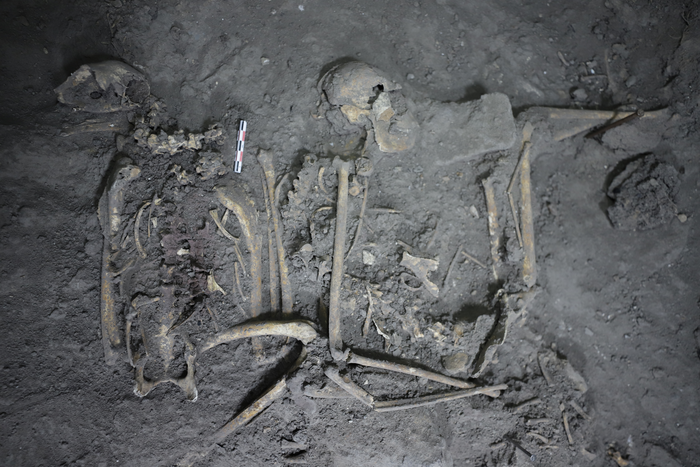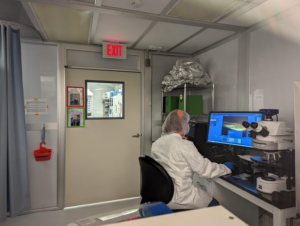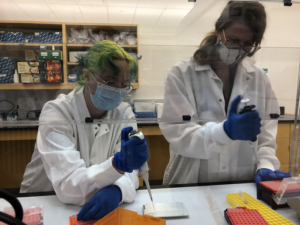1,700-year-old spider monkey remains discovered in Teotihuacán, Mexico
Researchers found thousands of other items, but the skeletal remains of the monkey point to the earliest evidence of primate captivity, translocation, and gift diplomacy between Teotihuacán and Mayan elite
The complete skeletal remains of a spider monkey — seen as an exotic curiosity in pre-Hispanic Mexico — grants researchers new evidence regarding social-political ties between two ancient powerhouses: Teotihuacán and Maya Indigenous rulers.

The discovery was made by Nawa Sugiyama, a UC Riverside anthropological archaeologist, and a team of archaeologists and anthropologists who since 2015 have been excavating at Plaza of Columns Complex, in Teotihuacán, Mexico. The remains of other animals were also discovered, as well as thousands of Maya-style mural fragments and over 14,000 ceramic sherds from a grand feast. These pieces are more than 1,700 years old.
The spider monkey is the earliest evidence of primate captivity, translocation, and gift diplomacy between Teotihuacán and the Maya. Details of the discovery will be published in the journal PNAS. This finding allows researchers to piece evidence of high diplomacy interactions and debunks previous beliefs that Maya presence in Teotihuacán was restricted to migrant communities, said Sugiyama, who led the research.
“Teotihuacán attracted people from all over, it was a place where people came to exchange goods, property, and ideas. It was a place of innovation,” said Sugiyama, who is collaborating with other researchers, including Professor Saburo Sugiyama, co-director of the project and a professor at Arizona State University, and Courtney A. Hofman, a molecular anthropologist with the University of Oklahoma. “Finding the spider monkey has allowed us to discover reassigned connections between Teotihuacán and Maya leaders. The spider monkey brought to life this dynamic space, depicted in the mural art. It’s exciting to reconstruct this live history.”
Researchers applied a multimethod archaeometric (zooarchaeology, isotopes, ancient DNA, paleobotany, and radiocarbon dating) approach to detail the life of this female spider monkey. The animal was likely between 5 and 8 years old at the time of death.
Its skeletal remains were found alongside a golden eagle and several rattlesnakes, surrounded by unique artifacts, such as fine greenstone figurines made of jade from the Motagua Valley in Guatemala, copious shell/snail artifacts, and lavish obsidian goods such as blades and projectiles points. This is consistent with evidence of live sacrifice of symbolically potent animals participating in state rituals observed in Moon and Sun Pyramid dedicatory caches, researchers stated in the paper.
Results from the examination of two teeth, the upper and lower canines, indicate the spider monkey in Teotihuacán ate maize and chili peppers, among other food items. The bone chemistry, which offers insight to the diet and environmental information, indicates at least two years of captivity. Prior to arriving in Teotihuacán, it lived in a humid environment, eating primarily plants and roots.
The research is primarily funded by grants awarded to Sugiyama from the National Science Foundation and National Endowment for the Humanities. Teotihuacán is a pre-Hispanic city recognized as an UNESCO World Heritage site and receives more than three million visitors annually.
In addition to studying ancient rituals and uncovering pieces of history, the finding allows for a reconstruction of greater narratives, of understanding how these powerful, advanced societies dealt with social and political stressors that very much reflect today’s world, Sugiyama said.
“This helps us understand principles of diplomacy, to understand how urbanism developed … and how it failed,” Sugiyama said. “Teotihuacán was a successful system for over 500 years, understanding past resilience, its strengths and weaknesses are relevant in today’s society. There are many similarities then and now. Lessons can be seen and modeled from past societies; they provide us with cues as we go forward.”
The University of California, Riverside is a doctoral research university, a living laboratory for groundbreaking exploration of issues critical to Inland Southern California, the state and communities around the world. Reflecting California’s diverse culture, UCR’s enrollment is more than 26,000 students. The campus opened a medical school in 2013 and has reached the heart of the Coachella Valley by way of the UCR Palm Desert Center. The campus has an annual impact of more than $2.7 billion on the U.S. economy. To learn more, visit www.ucr.edu.
Bibliographic information:
Earliest evidence of primate captivity and translocation supports gift diplomacy between Teotihuacan and the Maya, Proceedings of the National Academy of Sciences (21-Nov-2022), DOI: 10.1073/pnas.2212431119
Press release from the University of California – Riverside
Study Using DNA Analysis of Sacrificial Spider Monkey Suggests Mesoamerican Diplomacy
A multimethod archaeological study of a spider monkey sacrificed at Teotihuacàn, located approximately 25 miles from Mexico City, provides the earliest evidence of primate captivity and translocation in the Americas over 1,500 years ago.
Researchers at the University of Oklahoma’s Laboratories of Molecular Anthropology and Microbiome Research led the genetic analysis of the spider monkey’s skeleton. The OU team includes study co-authors Courtney Hofman, Ph.D., President’s Associates Presidential Professor in the Department of Anthropology, Dodge Family College of Arts and Sciences, with graduate student Robin Singleton and laboratory technician Karissa Hughes.
“Geoffrey’s spider monkeys are not found near Teotihuacàn today,” Hofman said. “Ancient DNA analysis of this spider monkey sought to identify the subspecies of the spider monkey, which can provide insight into ancient trade networks.”
“We were able to confirm that the spider monkey was most closely related to two endangered populations, the Mexican and the Yucatan spider monkey subspecies,” she added. “Using additional lines of evidence, including isotopic analysis, we hypothesized that this animal was of the Mexican subspecies, which today lives in parts of Mexico, Guatemala and Honduras. The presence of this animal in the central Mexican city of Teotihuacàn suggests that there was greater interaction with the Maya than previously understood and perhaps this spider monkey was a diplomatic gift.”
The study, Earliest evidence of primate captivity and translocation supports gift diplomacy between Teotihuacan and the Maya, was published Nov. 21 in the journal Proceedings of the National Academy of Sciences and was featured in Science.
Nawa Sugiyama, assistant professor of anthropology at the University of California, Riverside, is the first author. In addition to the OU team, co-authors include researchers from Arizona State University; the Archéologie des Amériques in Paris, France; the Smithsonian Museum Conservation Institute; the RIKEN Institute in Kobe, Japan; and Washington State University.
Press release from the University of Oklahoma





